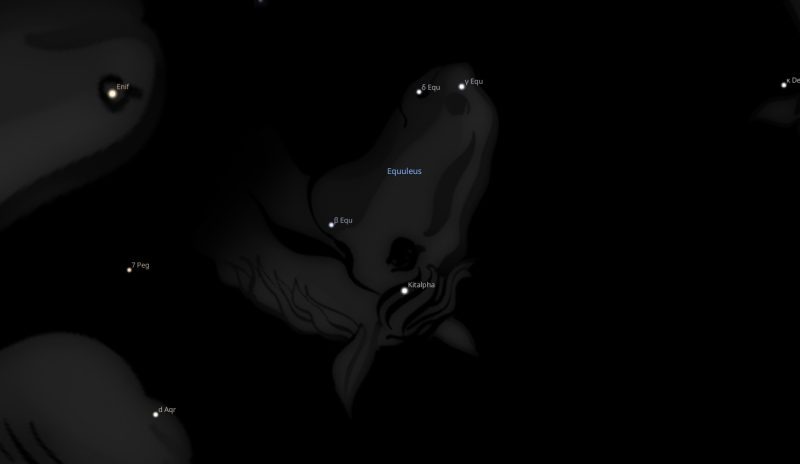FIXED STARS: Major Stars | 1000+ Stars | Constellations | About
Constellation Equuleus, The Foal, is a northern constellation bordering Aquarius, Pegasus, Delphinius and Aquila. It is one of the 48 constellations listed by Ptolemy in the 2nd century and remains one of the 88 modern constellations. Equuleus spans less than 5 degrees of the zodiac in the Sign of Aquarius.Equuleus Constellation Stars
| 2000 | 2050 | Star | Name | Sp. Class | Mag. | Orb |
|---|---|---|---|---|---|---|
| 23♒07 | 23♒49 | α Equ | Kitalpha | G0 | 3.92 | 1°30′ |
| 23♒25 | 24♒07 | γ Equ | F0 | 4.70 | 1°00′ | |
| 24♒26 | 25♒08 | δ Equ | Pherasauval | F5 | 4.47 | 1°10′ |
| 25♒26 | 26♒08 | β Equ | A3 | 5.16 | 1°00′ |
Equuleus Astrology
Robson
Legend. According to various accounts Equuleus represents Celeris, the brother of Pegasus; or Cyllarus, the horse of Pollux.
Influence. It gives friendship and sagacity but frivolity and love of pleasure. [1]
Noonan
Now called Equuleus (Equ), this constellation was barely mentioned by Ptolemy. He did not even give the stars their astrological designation. The bright star Kitalpha has a spectral nature of Mercury and Venus combined. But Ancient astrologers asserted that those born under these stars will be famous charioteers, teamsters or courier scouts. They may also be veterinarians in keeping with the Mercurial nature of its major star. [2]
Allen
Equuleus, the Foal.. lies half-way between the head of Pegasus and the Dolphin, marked by the trapezium of 4th‑ to 5th‑magnitude stars, — α, β, γ, and δ, — although Argelander catalogues nine others, and Heis twelve down to 6.7 magnitude. Thus “the flaming shoulders” of our motto are lacking here, and the reference may be to Pegasus, to which the characterization certainly is more appropriate.
The Germans call it Füllen, the Filly, and Kleine Pferd, which with us is the Little Horse, the French Petit Cheval, and the Italian Cavallino.
Ptolemy catalogued it as Ἵππου Προτομή, this last word equivalent to our Bust for the upper part of an animal figure; but with later astronomers it was Equus primus and prior, as preceding Pegasus in rising; while from its inferior size come our own title and Equulus, Equiculus, and Equus Minor.
Ptolemy’s idea of the incompleteness of the figure was repeated in the Equi Sectio, Equi Praesectio, Sectio equina, Sectio Equi minoris, Semi-perfectus, and Praesegmen of various authors and Latin versions of the Syntaxis and of the Alfonsine Tables; the Almagest of 1551 gave Praecisio Equi.
Chrysococca’s Tables had Κεφαλή Ἵππου, the Equi Caput of some Latin writers, and the Horse’s Head of our day.
The Arabians followed Ptolemy in calling it Al Kiṭʽah al Faras, Part of a Horse, Chilmead’s Kataat Alfaras; Al Faras al Thānī, the Second Horse, alluding either to its inferior size, or to the time of its adoption as a constellation; and Al Faras al Awwal, the First Horse, in reference to its rising before Pegasus. From the first of these comes the modern Kitalpha, sometimes applied to the constellation, and generally to the brightest star.
With the Hindus it was another of their Açvini, the Horsemen, although their figuring resembled ours.
Some of the mythologists said that the constellation represented Celeris, the brother of Pegasus, given by Mercury to Castor; or Cyllarus, given to Pollux by Juno; or the creature struck by Neptune’s trident from the earth when contesting with Minerva for superiority; but it also was connected with the story of Philyra and Saturn. Caesius, in modern times, associated it with the King’s Horse that Haman hoped for, as is told in the Book of Esther; and Julius Schiller, with the Rosa mystical. [3]
References
- Fixed Stars and Constellations in Astrology, Vivian E. Robson, 1923, p.44.
- Fixed Stars and Judicial Astrology, George Noonan, 1990. p.28.
- Star Names: Their Lore and Meaning, Richard H. Allen, 1889, p.212-214.

